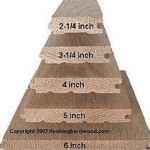How Do You Measure Up For Laminate Flooring Installation?
Laminate flooring, a versatile and cost-effective alternative to hardwood, has become a popular choice for homeowners seeking a durable and aesthetically pleasing flooring solution. However, a successful laminate flooring installation hinges significantly on accurate measurements. Imprecise measurements can lead to material shortages, excessive waste, and a final product that lacks a professional finish. This article delves into the essential aspects of accurately measuring a space for laminate flooring installation, ensuring a smooth and cost-efficient project.
Before embarking on the measurement process, gathering the necessary tools is crucial. These tools facilitate accurate and efficient data collection. The essential tools include:
*Measuring Tape:
A high-quality measuring tape, preferably one at least 25 feet in length, is fundamental. Choose a tape with clear, easy-to-read markings. *Pencil and Paper:
Essential for recording measurements as they are taken. A notepad or a dedicated measurement sheet will help organize the data. *Calculator:
A calculator will be required to perform calculations, such as converting measurements to square footage and accounting for waste. *Straight Edge or Ruler:
Useful for measuring small gaps and ensuring accurate alignment. *Graph Paper (Optional):
Graph paper can be helpful in creating a floor plan, especially for complex room shapes. *Laser Measure (Optional):
A laser measure can significantly speed up the process, particularly for larger rooms, and often provides more accurate measurements over longer distances.Having the right tools readily available will streamline the measurement process and contribute to accurate results.
The first step is to prepare the room for measurement. This involves clearing the space of all furniture, rugs, and other obstructions. This ensures that accurate measurements can be taken without encountering any obstacles. Pay close attention to any irregularities in the room's shape, such as alcoves, closets, or doorways. These areas will require careful and separate measurement to account for their unique dimensions.
Documenting the existing conditions of the subfloor is also important at this stage. Note any unevenness, cracks, or other issues that may need to be addressed before the laminate flooring is installed. This proactive approach can prevent problems down the line and ensure a stable and level surface for the new flooring.
Key Point 1: Determining Square Footage
The fundamental measurement for laminate flooring installation is the square footage of the area to be covered. This involves measuring the length and width of the room and multiplying these values to obtain the square footage. For rectangular or square rooms, this is a straightforward calculation. However, many rooms are not perfectly rectangular, requiring a more nuanced approach.
If the room is irregularly shaped, it should be divided into smaller, more manageable rectangles or squares. Each of these sections should be measured separately, and the individual square footage values should then be added together to obtain the total square footage of the room.
For example, if a room has an alcove, measure the alcove's length and width and calculate its area separately. Then, measure the main portion of the room, calculate its area, and add the two areas together to determine the total square footage. It is essential to be precise when measuring each section to minimize errors in the final calculation.
Another aspect to consider is doorways and areas under appliances that will not be covered by the laminate flooring. While these areas may seem insignificant, they can affect the overall amount of flooring needed, especially in smaller rooms. It is best to deduct their area from the total square footage, although this is less critical than accurate measurement of occupied floor space.
Once the total square footage is determined, it is necessary to account for waste. Laminate flooring installation typically involves cutting boards to fit around obstacles and at the edges of the room. This inevitably generates waste material. A general rule of thumb is to add 5-10% to the total square footage to account for waste. For rooms with many angles or complex shapes, a higher percentage of waste may be necessary.
For example, if the calculated square footage is 200 square feet, adding 10% for waste would result in a total of 220 square feet. This ensures that there is enough material to complete the installation without running short.
Key Point 2: Accounting for Obstacles and Irregularities
Accurate measurement goes beyond simply determining the square footage of the room. It also involves carefully accounting for obstacles and irregularities that may affect the installation process. These obstacles can include doorways, closets, pipes, and built-in features.
Doorways present a particular challenge, as the laminate flooring must be cut to fit around the door frame. Measure the width of the doorway and the distance from the wall to the door frame. This information will be needed to accurately cut the flooring boards to fit snugly around the doorway.
Closets should be measured separately, as they may require a different amount of flooring than the main room. Measure the length and width of the closet and calculate its square footage. This area should be included in the total square footage calculation for the project.
Pipes and other protruding objects require careful measurement and cutting. Use a ruler or straight edge to measure the distance from the wall to the center of the pipe. Also, measure the diameter of the pipe. This information will be needed to cut a circular hole in the flooring board to accommodate the pipe.
Built-in features, such as cabinets or fireplaces, may require custom cuts to ensure a seamless fit. Measure the dimensions of these features and note their location in the room. This information will be needed to create a detailed cutting plan for the laminate flooring.
When dealing with irregular shapes, such as curves or angles, it is often helpful to create a template. This can be done by tracing the shape onto a piece of paper or cardboard. The template can then be used to accurately cut the flooring boards to match the shape.
Another important consideration is the direction of the flooring boards. Laminate flooring is typically installed lengthwise along the longest wall of the room. However, in some cases, it may be necessary to install the flooring in a different direction to accommodate obstacles or to achieve a desired aesthetic effect. Determining the optimal flooring direction before taking measurements can help ensure a smooth and efficient installation process.
Key Point 3: Subfloor Evaluation and Preparation
While not directly a measurement aspect, the evaluation and preparation of the subfloor is integrally linked to accurate measurement and overall project success. The subfloor provides the foundation for the laminate flooring, and its condition significantly impacts the stability and longevity of the installation.
Before taking any measurements, thoroughly inspect the subfloor for any signs of damage or unevenness. Look for cracks, holes, or loose boards. These issues must be addressed before installing the laminate flooring.
If the subfloor is uneven, it may be necessary to use a leveling compound to create a smooth and level surface. Follow the manufacturer's instructions carefully when applying the leveling compound. Allow the compound to dry completely before proceeding with the installation.
If there are cracks or holes in the subfloor, they should be filled with a patching compound. Again, follow the manufacturer's instructions carefully and allow the compound to dry completely before proceeding.
Loose boards should be secured to the joists with screws. Ensure that the screws are long enough to penetrate the joists securely. If the boards are severely damaged, they may need to be replaced entirely.
In addition to addressing any structural issues, it is also important to clean the subfloor thoroughly. Remove any dust, dirt, or debris that may interfere with the adhesion of the laminate flooring. A vacuum cleaner or broom can be used for this purpose.
Once the subfloor is properly prepared, it is necessary to install an underlayment. Underlayment provides a cushion between the subfloor and the laminate flooring, reducing noise and improving the overall comfort of the floor. Choose an underlayment that is specifically designed for laminate flooring. Follow the manufacturer's instructions carefully when installing the underlayment. This layer adds height, so it is important to account for this when measuring transitions to other flooring types.
Finally, it is important to acclimatize the laminate flooring to the room before installation. This involves storing the flooring in the room for several days to allow it to adjust to the temperature and humidity. This will help prevent warping or buckling after installation.
By carefully evaluating and preparing the subfloor, a solid foundation for the laminate flooring installation is ensured, contributing to a long-lasting and aesthetically pleasing result.
Accurate measurement forms the cornerstone of a successful laminate flooring installation. By following the steps outlined in this article, homeowners can confidently approach the measuring process, minimizing the risk of material shortages, excessive waste, and installation challenges. Remember to take your time, double-check your measurements, and account for all obstacles and irregularities in the room. A well-measured space sets the stage for a flawless and professional-looking laminate flooring installation.

How To Measure Floor For Laminate 9 Steps With S

How To Measure A Room For Flooring

Laminate Floor Installation Tips

Guide To Installing Laminate Flooring Diy Family Handyman

Determining The Direction To Lay Install Hardwood Laminate Or Luxury Vinyl Plank Flooring

10 Great Tips For A Diy Laminate Flooring Installation The Happy Housie

The Ultimate Guide To Installing Laminate Flooring Parrys

How To Measure Rooms For Flooring Help Advice Leader Floors

How To Install Laminate Flooring On Your Own Diy Hq Longwood Fl

Diy Laminate Or Vinyl Flooring A To Z
Related Posts








